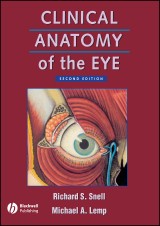Details

Clinical Anatomy of the Eye
2. Aufl.
|
80,99 € |
|
| Verlag: | Wiley-Blackwell |
| Format: | EPUB |
| Veröffentl.: | 09.04.2013 |
| ISBN/EAN: | 9781118691007 |
| Sprache: | englisch |
| Anzahl Seiten: | 432 |
DRM-geschütztes eBook, Sie benötigen z.B. Adobe Digital Editions und eine Adobe ID zum Lesen.
Beschreibungen
<b>Clinical Anatomy of the Eye</b> has proved to be a very popular textbook for ophthalmologists and optometrists in training all over the world. The objective of the book is to provide the reader with the basic knowledge of anatomy necessary to practice ophthalmology. It is recognised that this medical speciality requires a detailed knowledge of the eyeball and the surrounding structures. The specialist's knowledge should include not only gross anatomic features and their development, but also the microscopic anatomy of the eyeball and the ocular appendages. The nerve and blood supply to the orbit, the autonomic innervation of the orbital structures, the visual pathway, and associated visual reflexes should receive great emphasis. The practical application of anatomic facts to ophthalmology has been emphasised throughout this book in the form of Clinical Notes in each chapter. Clinical problems requiring anatomic knowledge for their solution are presented at the end of each chapter. Illustrations are kept simple and overview drawings of the distribution of the cranial and autonomic nerves have been included.
Preface;. <p>1. Development of the eye and the ocular appendages;.</p> <p>2. An overview of the anatomy of the skull;.</p> <p>3. The orbital cavity;.</p> <p>4. The paranasal sinuses;.</p> <p>5. The ocular appendages;.</p> <p>6. The eyeball;.</p> <p>7. The anatomy of the eyeball as seen with the ophthalmoscope, slit lamp, and gonioscope;.</p> <p>8. Movements of the eyeball and the extrocular muscles;.</p> <p>9. The orbital blood vessels;.</p> <p>10. Cranial nerves part I: Those nerves directly associated with the eye and orbit;.</p> <p>11. Cranial nerves part II: Those nerves not directly associated with the eye and orbit;.</p> <p>12. The autonomic nervous system;.</p> <p>13. The visual pathway;.</p> <p> Index</p>
"The most stunning aspect of this book is that the authors serve the needs of all levels of expertise...this format greatly aids the clinician...and guides the beginner..." American Journal of Ophthalmology on the first edition
Richard S Snell, MD, PhD, Emeritus Professor of Anatomy, The George Washington School of Medicine and Health Sciences, Washington D.C.<br /> <p><br /> </p> <p>Michael A Lemp, MD, Clinical Professor of Ophthalmology, Georgetown University Medical Center, President, University of Ophthalmic Consultants of Washington, Washington D.C.</p>
<b>Clinical Anatomy of the Eye</b> has proved to be a very popular textbook for ophthalmologists and optometrists in training all over the world. The objective of the book is to provide the reader with the basic knowledge of anatomy necessary to practice ophthalmology. It is recognised that this medical speciality requires a detailed knowledge of the eyeball and the surrounding structures. The specialist's knowledge should include not only gross anatomic features and their development, but also the microscopic anatomy of the eyeball and the ocular appendages. The nerve and blood supply to the


















